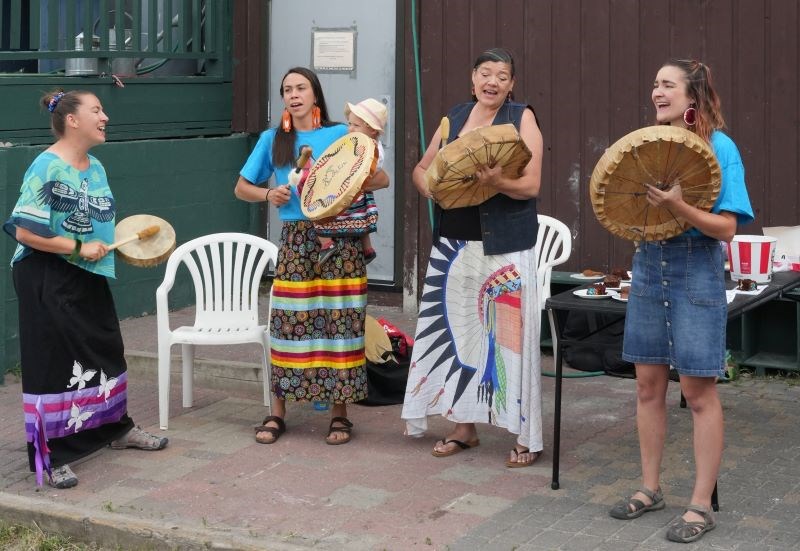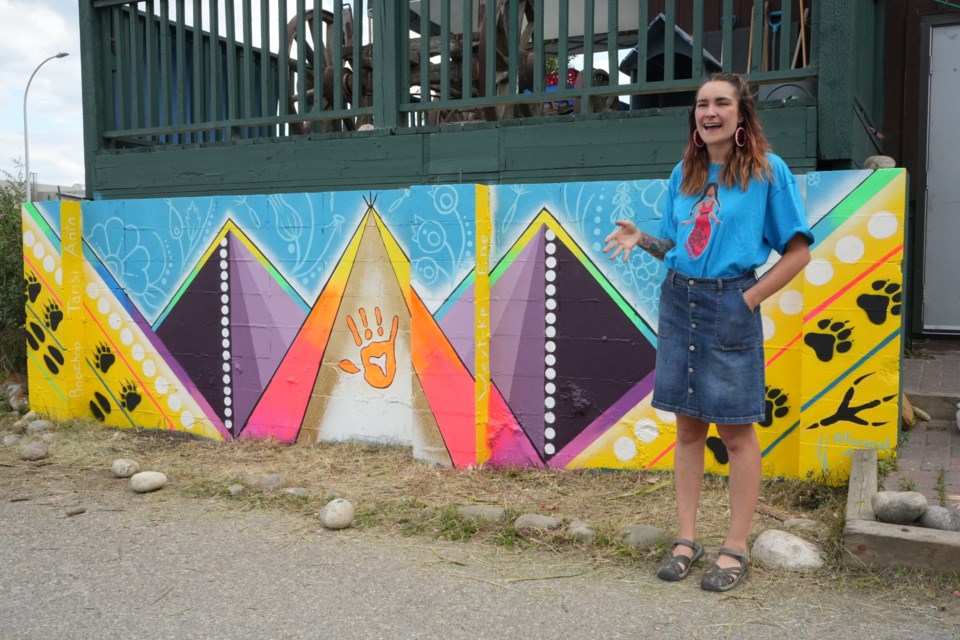Jason Stockfish | [email protected]
Where once stood a blank concrete wall, Indigenous artist Mackenzie Brown (Kamamak) created her vibrant and heartfelt mural titled ÔÇťWe Are Still Here.ÔÇŁ
On July 31, before a crowd of mesmerized onlookers, Brown unveiled her stunning piece on an outside wall of the Jasper Yellowhead Museum and Archives.
The piece includes a variety of vivid colours and symbols important to Brown, including plant life, a teepee, a handprint, wildlife footprints and intriguing geometric shapes and designs.
ÔÇťSomething that I love about Jasper as a community is the people, so each of the plants in the mural are from memories that I have with people,ÔÇŁ Brown said.
ÔÇťPlants and land connect us to people and that connects us to place.ÔÇŁ
For instance, one of the flora depicted in the mural, a strawberry, was inspired by a climb the artist and a friend went on at Watchtower, she explained.
In the middle of her mural, Brown painted a distinct teepee, and on either side of it are triangular shapes that one could see as mountains or teepees, which was BrownÔÇÖs intent when designing her work.
ÔÇťIt comes back to the idea of land and place and people, and that you canÔÇÖt disconnect one from the others,ÔÇŁ she said.
When viewing the mural, admirers will notice a shape found throughout is the circle, which holds a deep meaning for Brown and Indigenous peoples.
ÔÇťEverything happens in a circle. Ceremonies are in circles. Sharing is done in circles. The sun and the moon are circles,ÔÇŁ Brown said.
ÔÇťAnd itÔÇÖs that community coming together ÔÇô that (idea of) nobodyÔÇÖs ahead of one another. EveryoneÔÇÖs seen as being equals.ÔÇŁ

Also found in her piece are the footprints of four animals: the bear, the eagle, the bison and the wolf, which are the four sacred animals in Cree culture that offer important teachings, the artist noted.
Brown explained that her mural uses distinct lines and geometric shapes in a nod to Indigenous beadwork that tends to be very geometric but she also consciously contrasted these with elements that arenÔÇÖt linear.
ÔÇťBecause thatÔÇÖs how life is as well, so I like to have these different contrasts in my own work.ÔÇŁ
The colour scheme Brown used to express herself in her work is that of a rainbow, which possesses important themes for her. 
ÔÇťI use a lot of rainbows in my work,ÔÇŁ she said.
ÔÇťOne, for inclusivity, and two, it represents the Northern Lights to me and the colours we see in them.ÔÇŁ
For Indigenous communities, the aurora borealis represents their ancestors dancing in the afterlife, Brown said.
ÔÇťWe know that theyÔÇÖre safe up there having a little powwow in the sky, so thatÔÇÖs why I always include them.ÔÇŁ
BrownÔÇÖs Cree name is Kamamak, which means butterfly, and another reason why she uses a mixture of such vibrant colours is to stay true to her name, she noted.
The final piece of the mural that she chose to paint was the orange handprint.
This symbol is used by the Every Child Matters campaign, which is of significant relevance to Brown, having inspired the name of her mural. 
When Brown speaks of ÔÇťWe Are Still Here,'' she means that Indigenous people, their cultures and their ceremonies still remain on these traditional lands.
ÔÇťThat handprint really represents that, and it represents those who weÔÇÖve lost and future generations as well.ÔÇŁ
When asked about the power of public art, Brown said that for her it is an artistÔÇÖs ability to ÔÇťchange space.ÔÇŁ
ÔÇťArt has the ability to completely change the way you interact with an area, and we are inspired by the art around us, and I think that that is so beautiful,ÔÇŁ she added.
ÔÇťI am excited to take what I love about Jasper and put it into a piece.ÔÇŁ




